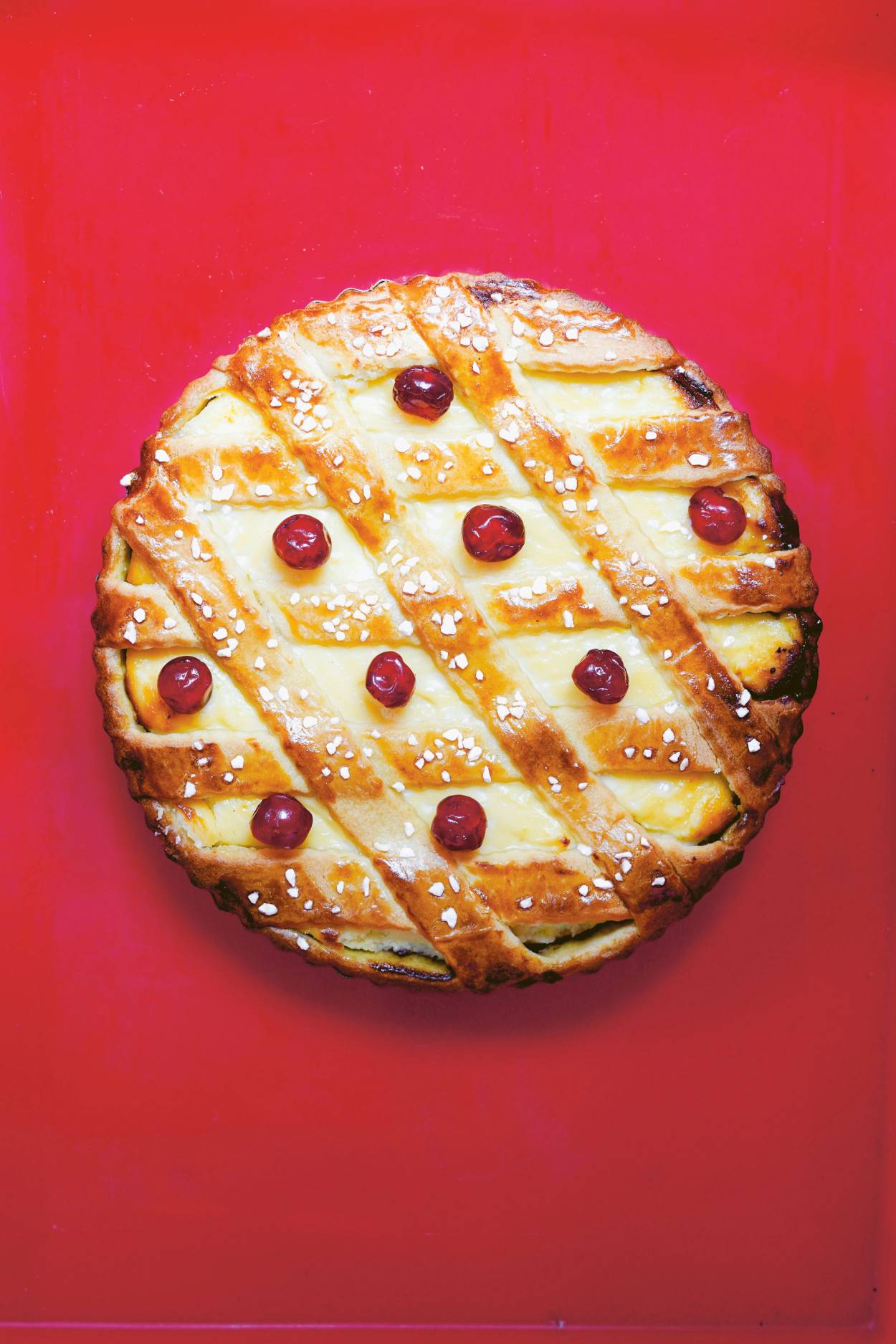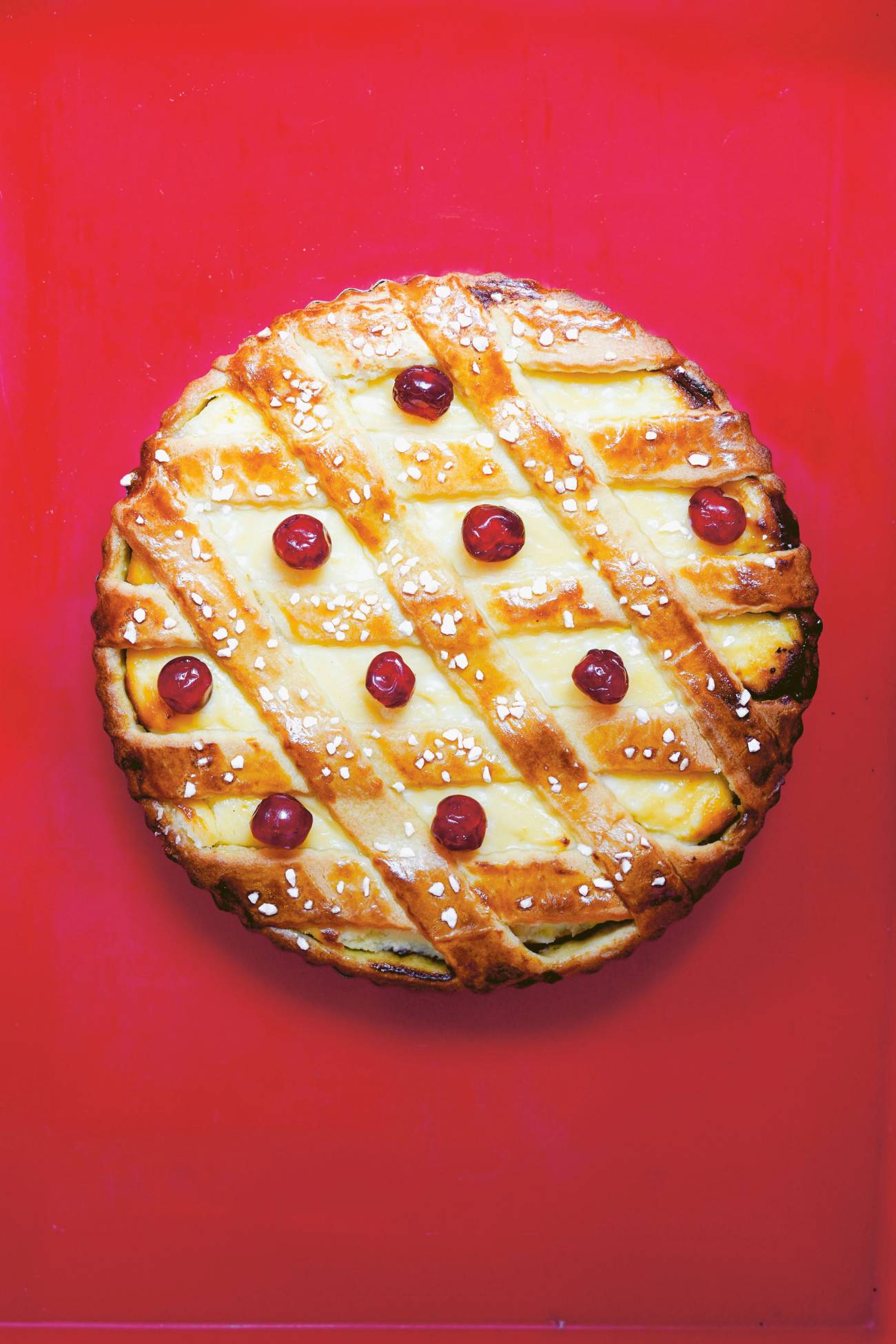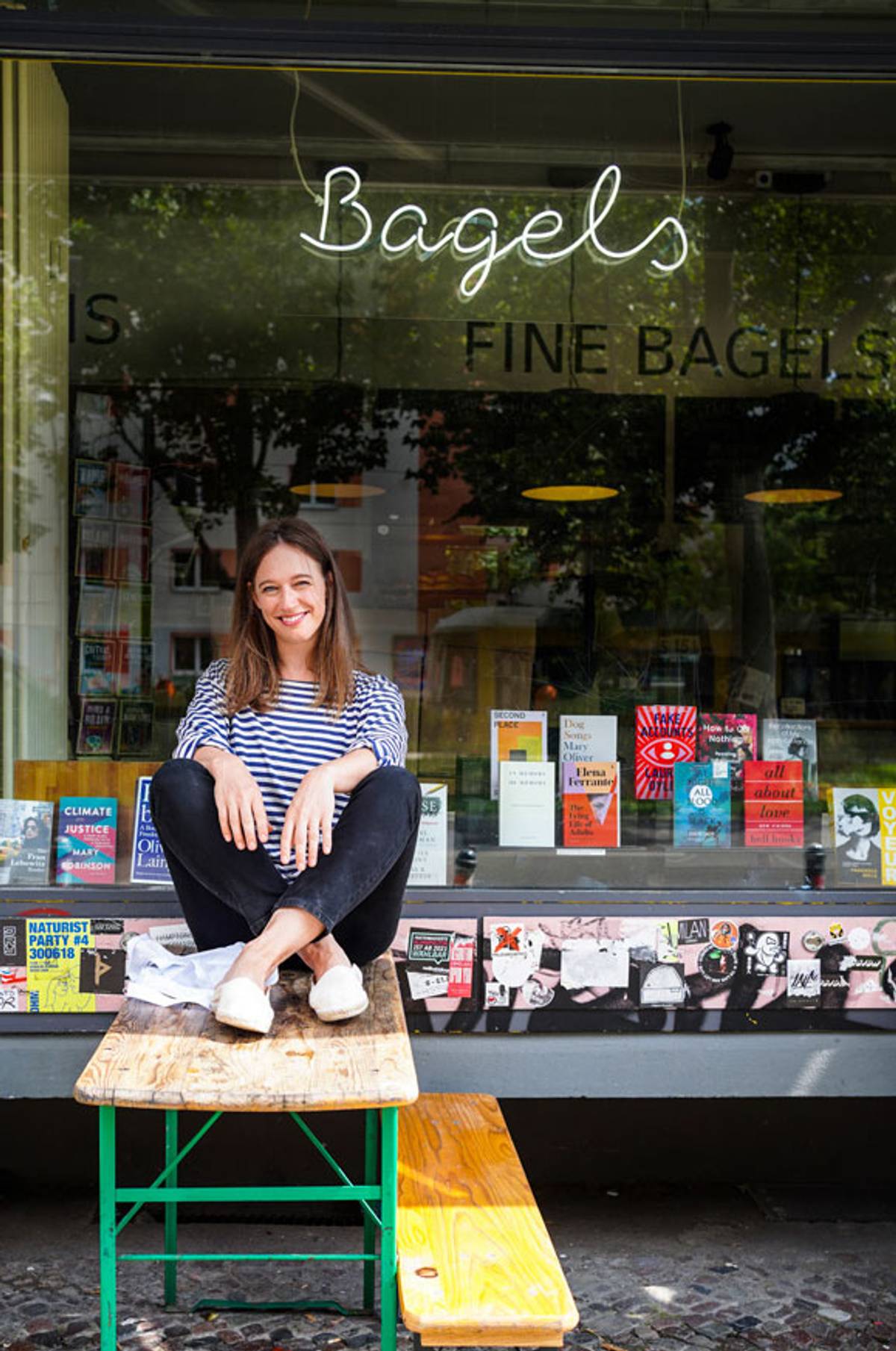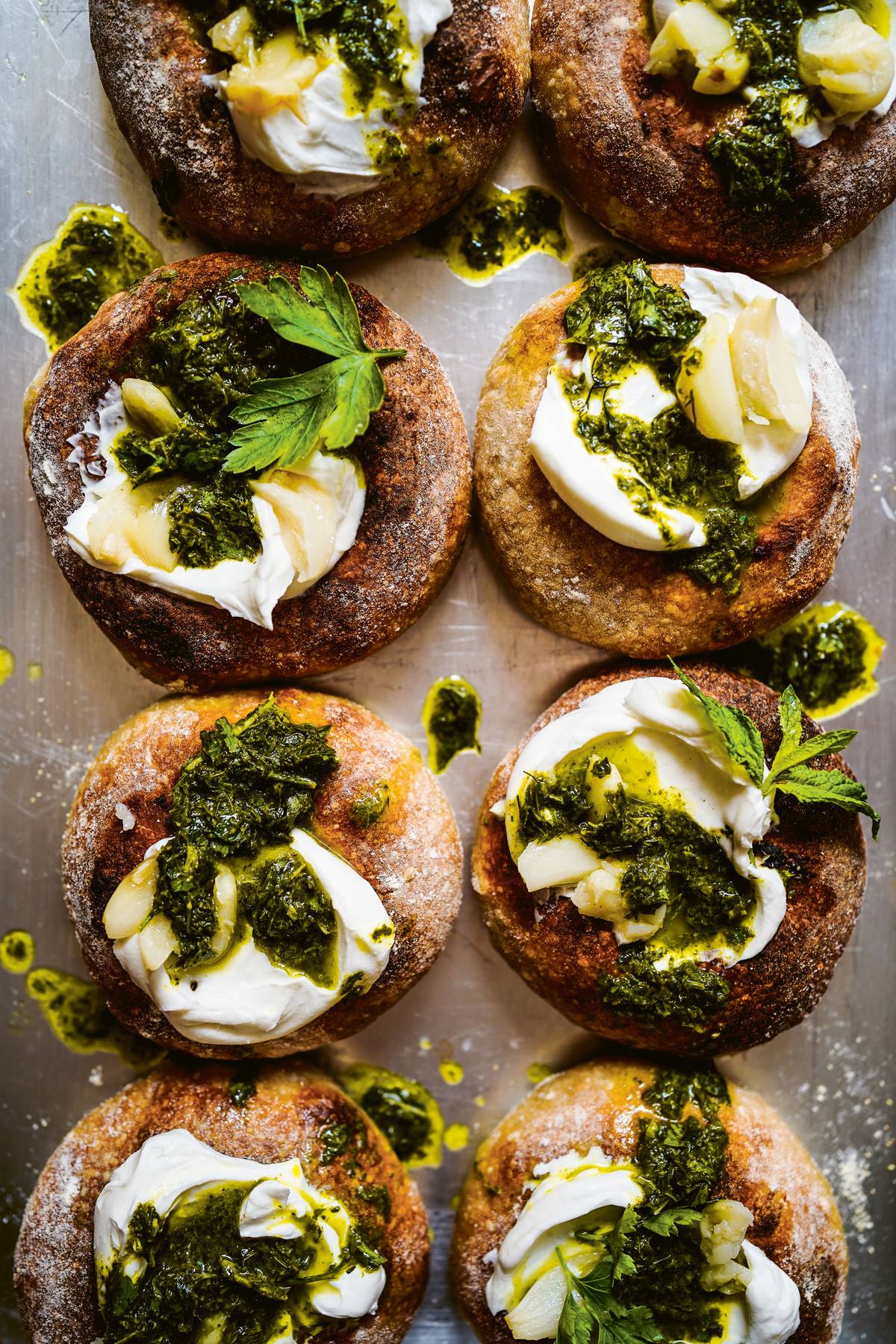Bringing Jewish Baking Home to Europe
In her new cookbook, Berlin-based American expat Laurel Kratochvila glimpses a revival of Ashkenazi recipes




Portuguese corn torte, brioche bread budding with roots in 11th-century England, and German Franzbrötchen with a caramelized cinnamon-sugar filling. Flipping through the pages of Laurel Kratochvila’s debut cookbook, New European Baking, pulls readers in and out of bakeries across the continent––just in time for home bakers to hibernate and heat up their winter kitchens with fresh breads and pastries.
Her collection of 99 recipes for breads, brioches, and pastries touches on all corners of Europe, from the ubiquitous French croissant to unique cross-cultural combinations, like nutty baklava danishes. But at the heart of it all, it’s hard not to notice dos pintele yid––the Jewish spark at the heart of it all.
Although hers is not an explicitly Jewish cookbook, Kratochvila weaves the history and evolution of Jewish baking into the pages like strands of a challah. The book is a mixture of European baking classics, like sourdough and a mountain of sweet and savory pastries, alongside her own creations. There’s her buttery challah croissant, a flan with tahini lending it a smooth sesame halva taste, and the Persia-meets-shtetl bialy with roasted garlic and lemony labne.
Combining her voice with the on-the-ground reality of 21st-century European baking, Kratochvila’s book sits firmly at the intersection of European and Jewish baking.
Tables are full just about any day of the week at Kratochvila’s Berlin bakery, Fine Bagels, named after her mother’s maiden name. The bakery sits on busy Warschauer Strasse, right off the M10 tram in Berlin’s Friedrichshain neighborhood. It’s a pocket of the city where strollers are few and far between. You’re more likely to find a mishmash of punks and anarchists surrounding a disheveled picnic table full of beer bottles on a Späti (convenient store) patio mixed with young, creative types hunting down their next pad thai or falafel.
Then there’s Fine Bagels—a world unto itself in Berlin. The heymische Jewish bakery blends seamlessly into a bookshop that blankets visitors with stunning graphic novels and cookbooks that you can’t resist flipping through. The walls are lined with shelves full of books reaching toward the ceiling, ranging from peeks into Berlin history and memoirs to science fiction and literary classics. And of course, there’s no shortage of Jewish cookbooks.
Visitors can often spot Massachusetts-born Kratochvila and her Czech husband, Roman, weaving through lines of hungry noshers and serving up a variety of bagels with lox and schmear and mugs of filtered black coffee.
Hani Portner, a Fine Bagels regular, grew up in the East Bay of San Francisco before moving to Berlin in 2018 for university. “I love bagels so much,” said Portner, who now works as a Jewish history tour guide, noting that Kratochvila’s bagels offer the chewiness of the ones they grew up eating in California. “I wake up and I dream of them when I don’t have them.”
Julie Shipley, a communications professional from California, offers similar praise: “I preorder their rye bagels in large quantities when I have a craving or pangs of nostalgia,” she said. Her partner, Martin Tschitschke, is a Berlin-born IT manager whose familiarity with Jewish food was minimal prior to their relationship—and prior to eating at Fine Bagels. “I learned that many culturally Jewish staple foods overlap with German ones, like latkes and Kartoffelpuffer,” he explained.
Kratochvila noticed the same kind of overlap.
It’s been 17 years since Kratochvila left the U.S. and moved to Prague. “I’ve spent my whole adult life here, mostly in Central Europe,” she told me, with a hint of sudden realization.
Kratochvila spotted the similarities between Jewish American and European baking early on in her European life: “I noticed all kinds of things that were very familiar to me from Jewish bakeries back home,” she recalled. “A lot of poppy seed filling and braided egg bread, powidla––a dense plum butter—and sweet cheese filling and all of these elements that I strongly associated with Jewish baking.”
That connection intensified during frequent visits to Poland, where she says Jews used to make up about half of the bakers.
“It was one of those permitted professions,” she explained. “So there was a huge amount of exchange and overlap that’s still present in Polish baking.”
The most obvious example is the Polish chalka, which is challah and as visible in the wild of Polish bakeries and grocery stories as croissants are in France.
Of course, Jewish and European baking have their differences. They part ways at what Kratochvila calls “the lard divide.”
“There’s a lot of lard baking that happens in sweet breads,” she said. “You would never find that in Jewish baking.”
Something special has been blossoming over the past decade in Europe, and perhaps unexpected given the horrific shadow of the Holocaust.
“One thing that’s happening in this new wave of European baking is that there is a revival of traditional Ashkenazi baking that’s happening across Europe,” said Kratochvila.

She calls it the “babka effect,” where you have a baked good that goes viral, thanks to social media. There’s a popularization of traditional Ashkenazi baked goods, like challah, rugelach, and of course, babka. A non-Jewish European baker might come across these images on Instagram and want to create them for their own bakery without knowing where the recipes originally come from. Does anything photograph better than a babka with chocolate or cinnamon filling oozing out of its strands?
And then there are the Jews themselves—like Kratochvila—who are moving to Europe and bringing their recipes with them. “It’s a bit of a reverse migration,” she said, referring to North American Jews who descended from Eastern European Jews and are moving back to Europe a couple generations or more after their ancestors left. Jews like Kratochvila are hungry for the bagels, babka, and bialys they used to eat in the U.S. When they can’t find them, they set up shop themselves, which is precisely why Kratochvila opened Fine Bagels in 2012.
Different kinds of flour, more eggs, and more money in the United States changed recipes and tastes for American Jews over the course of 120 years. Now those slightly evolved recipes are coming back east to a mixing bowl that isn’t as familiar with Jewish baking traditions.
“I think this is bringing more of a spotlight on Jewish baking in Europe,” she said.
Meike Peters, a James Beard Award-winning cookbook author and blogger from western Germany, met Kratochvila when she interviewed her for her food blog, Eat in My Kitchen. “We clicked from the start,” said Peters. “I always had this feeling with Laurel that it goes beyond baking.” Peters—who connected Kratochvila with her publisher—says she didn’t know much about Jewish food before they met. But it was through her friendship with Kratochvila (and frequent patronage to her bakery) that she fell in love with rugelach for the first time.
“The Jewish food scene has grown in Berlin in the past decade, but I think the Ashkenazi influence is still often forgotten,” said Liv Fleischhacker, the Berlin-born author of Masel Tov, a German-language Jewish cookbook. Milchzopf, for example, can be traced back to challah. “So many of what we consider to be ‘German baked goods’ have a Jewish background.”
One of the more interesting components of New European Baking and what’s happening in bakeries across the continent is how it gives a glimpse into how Jewish baking might have evolved organically were it not for the Holocaust.
“Frankly, there’s a lot of negative space for Jewish food in Europe,” said Kratochvila. “It should have organically blossomed and spread and grown bigger, but obviously that was cut down.”

At the same time, it would be a mistake to paint Europe as completely bereft of Jewish breads and pastries until recently. There are examples of foods that went extinct, like the bialy from Białystok, Poland. But there were gentile bakers who kept making the same recipes as they did when working with Jewish bakers before WWII, which explains why you’d be hard-pressed to find a Polish bakery without loaves of chalka for sale.
In light of the historical reality, Kratochvila said she’s happy to see non-Jewish bakers including Jewish recipes in their bakeries. “I think that’s good for Jewish food.”
The book is a reflection of this complex history and migration with blurred culinary borders. Although you might not be able to find a bialy in Białystok anymore, you can find it on page 38 in its traditional poppyseed and onion form and again on the next page with a Persian twist. And ever the reverse culinary migrant, Kratochvila says she’ll soon stock up Fine Bagels with bialys once again.
There’s a recipe for her own “Gooey Chocolate Rugelach” where she confesses to serving only the American-style, cookielike crescents stuffed with fruit and nuts when she first opened Fine Bagels 10 years ago. But half of her customers come from Israel, where rugelach are yeasted and sticky, “oozing with gooey chocolate and cinnamon.” As Kratochvila puts it, these rugelach attract bees. The recipe reflects the intersection of European, American, and Israeli influences in Berlin. (Of course, if you prefer something closer to what you’ll find as rogale in modern Polish bakeries, there’s a recipe for “Heymische Rugelekh” that taste “somewhere between sunshine and cinnamon toast.”)
On page 139, you can find the “Poppy and Sweet Cheese Koláčky,” a pastry that pushed Kratochvila down a flavorful memory lane.
“I remember tasting this in the Czech Republic for the first time and thinking there’s something so familiar about it,” she said. “This thick poppy filling and sweet cheese. It tasted like a perfect Danish or coffee cake to me. So this isn’t necessarily Jewish baking, but these are very Ashkenazi flavors. It’s just that they’re also very Czech flavors.”
For some American Jews, living in Europe is still unimaginable in the aftermath of the Holocaust. But for Kratochvila, it’s changed her relationship with Jewishness.
“I stopped taking it for granted. It’s not just passively around me all the time,” she said. Back in Sharon, Massachusetts, there were a slew of bakeries to pick from where she could get her fix of bagels and challah. “We live in Berlin. You have to search it out.”
Although American readers might have the luxury of Jewish bakers in their backyard, New European Baking still yields surprises you aren’t likely to find anytime soon in the U.S. There’s the “Roman Jewish Crostata Ricotta e Visciole––Ricotta and Sour Cherry Pie.” It’s a specialty of Jewish bakeries in Rome, Kratochvila writes, that she just happened upon during a visit to the Italian capital. Strands of the crust crisscross like a lattice pie with burgundy-colored cherries resting on the ricotta like tiny buttons.
The pristine images might intimidate a novice, but Kratocvhila hopes ambitious home bakers take a stab at the recipes.
“I really dove into how you can do this step by step,” she said. “I was really meticulous, so I hope it’s just in general a very good instruction manual for successful home baking.”
Joe Baur is a Berlin-based writer, author, and filmmaker from Cleveland.